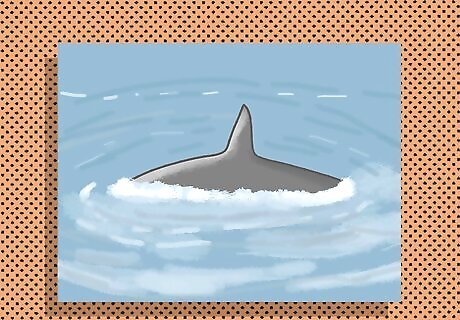
views
Best of luck with your viewing experiences!

Take Pictures Of... Dorsal FinIdentify an Orca Whale Step 1Bullet1.jpg Saddle Patch Identify an Orca Whale Step 1Bullet2.jpg TailIdentify an Orca Whale Step 1Bullet3.jpg

Take Notes in Journal or Sketchbook If you can't get a picture, sketch or note things like approximate size, Behaviors, and markings, nicks, or scars on the dorsal fin or tail.Identify an Orca Whale Step 2Bullet1.jpg

Use Information for Identification Colors and Markings:Orcas have very bold black-and-white coloring. Their backs are black; chests and lower jaw are white, along with a white patch positioned above and behind the eye. There are variable gray to white-colored saddle patches behind the dorsal fin. Residents have a variety of saddle patch pigmentations and five different patterns have been noticed. Transients have only two patterns that have been noticed. Identify an Orca Whale Step 3Bullet1.jpg Dorsal Fin:Resident whales have long dorsal fins that are curved at the tip. Transient adult males' are elongated and very straight at the tip. Male dorsal fins can reach 6 feet (1.8 m) and are more elongated than females. The dorsal fin on females can reach 3–4 feet (0.9–1.2 m) long and are more curved than the male's fin, similar to the juvenile Orca.Identify an Orca Whale Step 3Bullet2.jpg Size: (know the size of your boat beforehand to compare with whale size)Identify an Orca Whale Step 3Bullet3.jpg Males-The average length is 26–32 feet (7.9–9.8 m) and can weigh nearly 22,000 lbs.Identify an Orca Whale Step 3Bullet4.jpg Females-The average length is up to 28 feet (8.5 m) and they can weigh up to 16,500 lbs.Identify an Orca Whale Step 3Bullet5.jpg Tail: Orcas have lobes on their two-lobed tail that are called flukes. Take note to the shape of the tail and if any unique patterns or marks are visible.Identify an Orca Whale Step 3Bullet6.jpg

Behaviors or Unique Markings:Besides having one blowhole, they are also known for coming out of the water in a certain way that is called breaching or spyhopping. Take notice to any scars or nicks you may see in their fins or unique markings. All of these things can help properly identify which whale it is.

Look at Orca Types Five Known Types Exist (depending upon geographical location) Resident: dorsal fins more rounded at tip, larger pods Transient: dorsal fins more erect and elongated, smaller pods. Offshore: dorsal fins slightly rounded but tip differs slightly from Residents Atlantic (type A, B, C)

CAUTION!! Be careful not to confuse your Orca with a False Killer WhaleIdentify an Orca Whale Step 6.jpg

Identify an Orca There are several sites to help identify a specific whale using the information you've collected.Identify an Orca Whale Step 7Bullet1.jpg http://www.nmfs.noaa.gov/pr/species/mammals/cetaceans/killerwhale.htm Please report your sightings to the below sources. Some questions they may ask:Identify an Orca Whale Step 7Bullet2.jpg Number of animals seen? Where did you see them (latitude and longitude if possible)? When did you see them (date and time of day)? What were they doing? Playing? Feeding, on what? Were there any males (very large fin on their back)? Any unusual markings? Scars? Have you see killer whales in this area during winter months in previous years? Did you get pictures of any killer whales?

Report Sightings BC cetacean sightings network http://wildwhales.org/sightings/ Cascadia Research http://www.cascadiaresearch.org

HAVE FUN AND ENJOY THE EXPERIENCE!




















Comments
0 comment